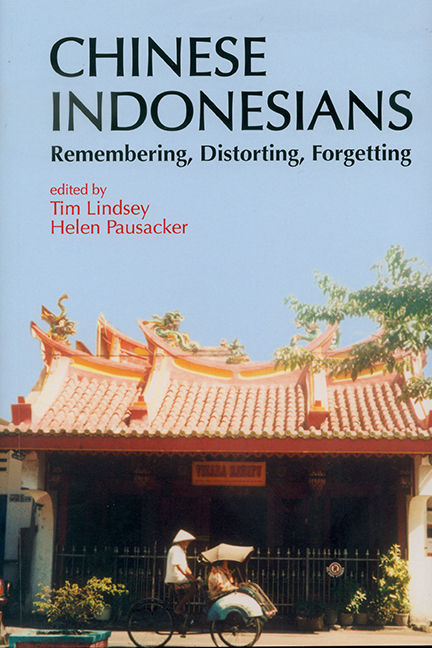Book contents
- Frontmatter
- Contents
- Preface
- A Brief Biography
- Contributors
- Glossary
- Introduction: Researching the Margins
- Bibliography of Charles Coppel's Work
- 1 Anti-Chinese Violence and Transitions in Indonesia: June 1998–October 1999
- 2 Reconstituting the Ethnic Chinese in Post-Soeharto Indonesia: Law, Racial Discrimination, and Reform
- 3 Buddhism and Confucianism in Contemporary Indonesia: Recent Developments
- 4 Portrait of the Chinese in Post-Soeharto Indonesia
- 5 The Makam Juang Mandor Monument: Remembering and Distorting the History of the Chinese of West Kalimantan
- 6 Confucianists and Revolutionaries in Surabaya (c1880–c1906)
- 7 The Chinese and the Early Centuries of Conversion to Islam in Indonesia
- 8 The Agony of Love: A Study of Peranakan Chinese Courtship and Marriage
- 9 Peranakan Chinese and Wayang in Java
- Index
1 - Anti-Chinese Violence and Transitions in Indonesia: June 1998–October 1999
Published online by Cambridge University Press: 21 October 2015
- Frontmatter
- Contents
- Preface
- A Brief Biography
- Contributors
- Glossary
- Introduction: Researching the Margins
- Bibliography of Charles Coppel's Work
- 1 Anti-Chinese Violence and Transitions in Indonesia: June 1998–October 1999
- 2 Reconstituting the Ethnic Chinese in Post-Soeharto Indonesia: Law, Racial Discrimination, and Reform
- 3 Buddhism and Confucianism in Contemporary Indonesia: Recent Developments
- 4 Portrait of the Chinese in Post-Soeharto Indonesia
- 5 The Makam Juang Mandor Monument: Remembering and Distorting the History of the Chinese of West Kalimantan
- 6 Confucianists and Revolutionaries in Surabaya (c1880–c1906)
- 7 The Chinese and the Early Centuries of Conversion to Islam in Indonesia
- 8 The Agony of Love: A Study of Peranakan Chinese Courtship and Marriage
- 9 Peranakan Chinese and Wayang in Java
- Index
Summary
INTRODUCTION
In Indonesian Chinese in Crisis Charles Coppel describes the period of transition in late 1965 and into 1966 and 1967 as “this two year period of storm” (Coppel 1983, p. 60). He depicts a time when tensions between Indonesia and China, as well as the residues of the anti-communist purges and an economic crisis, saw escalating uncertainty for ethnic Chinese Indonesians. As Coppel describes it, this minority were considered a viable scapegoat at the time: “They could credibly be represented as communist menace, fifth column and economic saboteur” (Coppel 1983, p. 63). Incidents of violence against the Chinese took place frequently and signified a disturbing trend.
Coppel and other historians estimate that the number of Chinese killed during the communist purges in 1965–66 could not have exceeded 2,000 from the total number of deaths of up to 500,000. However, as his study shows, anti-Chinese sentiment escalated in the two years following the killings for various reasons, some of which were related to the anti-communist purges, and others which were not. These incidents included attacks on Chinese consulates in Makassar and Medan in late 1965; and more ominously, beginning in April 1966, the expulsion of 10,000 Chinese from Aceh and a similar number from West Kalimantan in 1967. As Coppel puts it, “The anti-Chinese violence during the two years after the coup attempt was unprecedently widespread” (Coppel 1983, p. 60). This marked a transformation in how ethnic Chinese could live their lives in Indonesia, foreshadowing laws and regulations implemented by the New Order government that confirmed and enhanced these prejudices and discriminatory practices.
- Type
- Chapter
- Information
- Chinese IndonesiansRemembering, Distorting, Forgetting, pp. 14 - 40Publisher: ISEAS–Yusof Ishak InstitutePrint publication year: 2005

